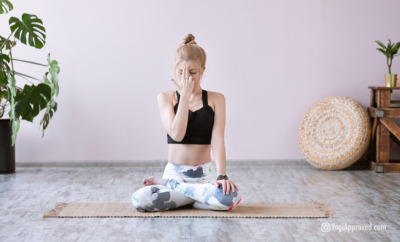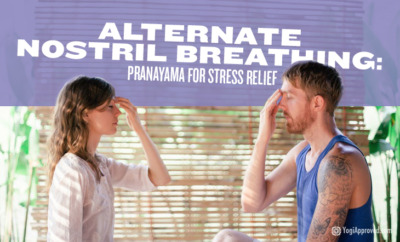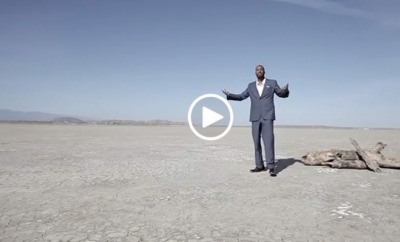Need a Natural Energy Boost? Here Are 3 Breathwork Practices to Pick You Up

We’ve all had that day before. The one where even bottomless coffee doesn’t boost our energy or wake us up. Some simple breathing exercises might be what you need to give you a natural energy boost and kick off your day.
Breathwork, or Pranayama, is one of the eight limbs of yoga and a foundational part of any yoga practice. “Prana” translates as life energy, and “yama” means control.
Pranayama, therefore is a practice of controlling our breath to affect the flow of energy, stress, bliss and emotions in our body.
What Are the Eight Limbs of Yoga? Here’s Your Comprehensive Overview
Even in the non-yoga world you might have heard things like “take 3 deep breaths” or “count to ten” to help you calm down or respond to a situation.
Breathwork comes in many forms. From quick pulsing breaths to long drawn-out inhales and exhales, from breath retention to over breathing. These have different purposes and can be used to solicit a specific response in our body.
Some forms of breathwork help us calm down and relax after a long day. Others provide us with a boost of energy and awaken our body and mind.
Pranayama for Stress Relief: Use These 3 Yogic Breathing Exercises to Calm Down
3 Breathing Exercises for a Natural Energy Boost:
Try these three Pranayama exercises when you need a natural energy boost.
1. Skull Shining Breath (Kapalabhati)
This breathwork has one of the most vivid and descriptive names. In Sanskrit Kapala means skull, and bhati means shining, making this Skull Shining or Skull Illuminating Breath.
Kapalabhati is different than many other breathwork techniques, as it focuses on the exhale rather than the inhale.
In this practice you will rapidly and dynamically exhale through your nose. So much so it seems like you are cleaning out or shining your skull! The forceful exhale is followed by a passive inhale, all powered by rhythmic abdominal thrusts.
Let’s try it:
- Find a comfortable yet active seat on the floor or a chair
- Do not do this breathwork while standing, as that can create some dizziness
- Gently lengthen through the back of the neck and pull your chin down ever so slightly
- Close your mouth to seal your lips
- Rest your hands on your legs, or take a mudra if you would like
- Start by taking a slow and complete inhale and exhale
- Next inhale to about 2/3rds capacity
- Then begin to vigorously exhale through your nose by forcefully pulling your navel in towards your spine
- This is an active inward pull or thrust of the front abdominal wall
- Follow this by releasing your core muscles and allow air to passively enter for your inhale
- Your stomach will move in with the exhale, and out with the inhale
- Sometimes it helps to bring one hand to the belly to feel it moving in and out while learning this breathwork
- The rhythm is quick, with the exhales short and forceful and the inhales slower and relaxed
- Start with twenty repetitions of exhales and inhales
- When you’re finished with one round, take another slow and complete inhale and exhale
- Repeat for up to three rounds of twenty repetitions, taking as many slow breaths as needed between rounds
- Beginners will take about a second for each exhale, and one or two seconds for the inhale
- With practice you can increase both the speed of your breathing as well as the number of repetitions per round
Not Sure What Your Front Abdominal Wall Means? Read: Abdominal Anatomy + Yoga Poses to Strengthen Your Full Core
2. Breath of Joy
This is an aptly named breathing exercise without a corresponding Sanskrit name. It’s hard to complete Breath of Joy without smiling and possibly even laughing.
This breathwork involves the entire body and is sure to give you a quick, natural energy boost. It’s completed standing up and pairs arm movements, breath control, a forward fold and an audible “HA” sound.
You’ll swing your arms up and out a bit like an exaggerated conductor while breaking your inhale into three parts, and then enjoy a luxurious exhale.
Pranayama, therefore is a practice of controlling our breath to affect the flow of energy, stress, bliss and emotions in our body.
This breathwork awakens your whole body and helps to release tension.
Let’s try it:
- Check your surroundings to make sure you won’t hit anything or anyone with your arm movements
- Inhale 1/3 of the way as you swing your arms out in front of you to shoulder height
- Inhale to 2/3rd capacity as you swing your arms open to the side
- Inhale the rest of the way to full capacity as you swing your arms overhead, keeping your arms parallel and the palms facing each other
- Your elbows can stay bent with the arms soft rather than ridged for these motions
- Then take one big exhale as you make the sound “HA”
- During the exhale, swing down hinging at the hips and allow your arms to dangle towards the ground or past your legs
- Then roll back up to standing as you swing your arms up to shoulder height again repeating the first step of the three-part inhale
- Be sure to keep your knees bent during both the standing and forward fold movement
- Repeat up to ten times
- After completing breath of joy take a few regular breaths in Mountain Pose (Tadasana Pose) and enjoy the invigorating feeling
Start in a standing position with your knees soft, your feet about shoulder distance apart or a bit wider, and your arms down by your side
3. Right Nostril Breathing (Surya Bhedana)
This warming and energizing breathing exercise focuses on breathing in through the right nostril and out through the left. You’ll use Vishnu Mudra to close off one nostril at a time.
In Sanskrit, Surya means sun, and Bhedana means piercing, making this Sun Piercing Breath. Use this breathwork exercise whenever you need a bit of internal sunshine to warm your body or soul. Pure, natural energy boost!
Let’s try it:
- Start in a comfortable meditation seat such as Easy Seat, Lotus Pose, or Hero Pose
- Take Vishnu Mudra with your right hand: curl your index and middle finger in towards your palm while leaving your thumb, pinkie and ring finger extended
- Press your ring and pinkie finger into your left nostril to close it off
- Close your eyes
- Inhale slowly and completely through your open right nostril
- Retain your inhale as you plug your right nostril with your thumb
- Release your pinkie and ring finger to open our left nostril
- Exhale slowly and completely though your open left nostril
- This is one cycle
- Repeat the cycle as many times as desired by breathing in through the right nostril and out through the left
- You may add breath retention to this practice as desired by lengthening your inhales, retaining the breath, and lengthening the exhales at a 1:4:2 ratio
- For example, four count inhale, sixteen count hold, eight count exhale
- After completing the desired cycles, release your mudra and take a few even inhales and exhales through both nostrils
Want to Work With Other Mudras? Read: Common Mudras, Their Meaning, and How to Practice Them
Try Guided Breathwork With Us on YA Classes by YouAligned!
Join Berlin-based YA Classes teacher Katy Scherer as she guides you through a simple, feel-good breathwork practice that you can revisit anytime!
Get a Natural Energy Boost with Breathing Exercises
There are numerous benefits to breathwork beyond a natural energy boost.
A routine breathwork practice may help to expand lung capacity, balance your nervous system, increase stamina, help to improve focus, cleanse the lungs, aid with digestion and strengthen the diaphragm and abdomen.
Use caution if you have high or low blood pressure, glaucoma, or experience vertigo. If you find any of these breathing exercises cause dizziness you may benefit from slowing down the rhythm, number of cycles or taking a longer break between rounds.
One of the great benefits of breathwork is it can be done almost anywhere. From your desk at work, to the waiting area at the airport, this practice can happen at any time.
Next time you find yourself struggling to wake up, or falling asleep in the afternoon at your desk, try one of these three breathing exercises to give yourself a natural energy boost. You might find yourself to be bright-eyed and bushy-tailed after all.


This Month's Letter
From the Editor
Monthly motivation and food for
thought from our founder.




























Comments